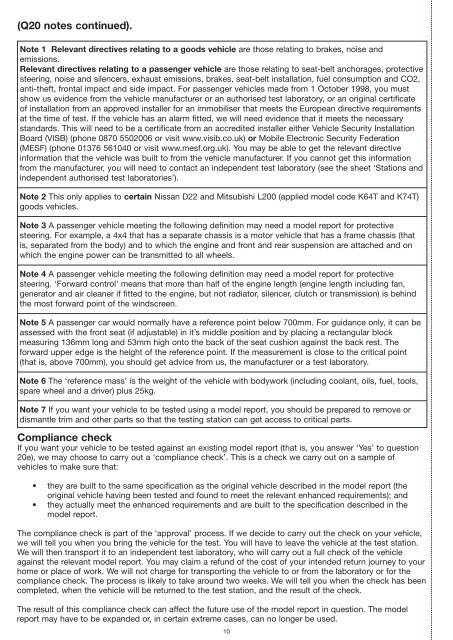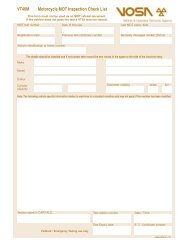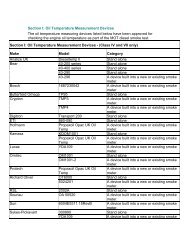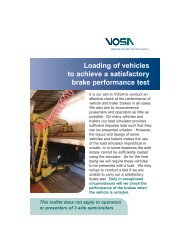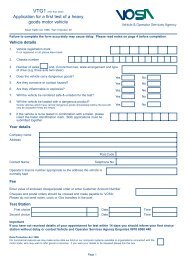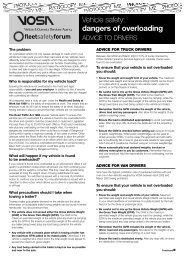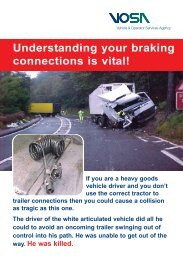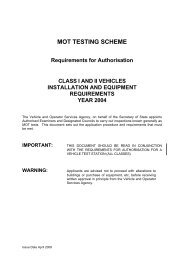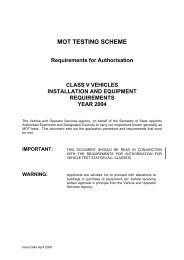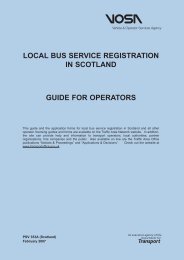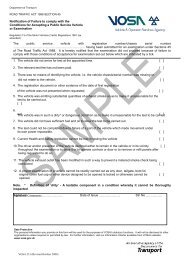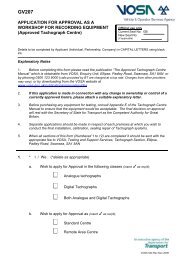Single Vehicle Approval (SVA) - Driving, transport and travel
Single Vehicle Approval (SVA) - Driving, transport and travel
Single Vehicle Approval (SVA) - Driving, transport and travel
Create successful ePaper yourself
Turn your PDF publications into a flip-book with our unique Google optimized e-Paper software.
(Q20 notes continued).<br />
Note 1 Relevant directives relating to a goods vehicle are those relating to brakes, noise <strong>and</strong><br />
emissions.<br />
Relevant directives relating to a passenger vehicle are those relating to seatbelt anchorages, protective<br />
steering, noise <strong>and</strong> silencers, exhaust emissions, brakes, seatbelt installation, fuel consumption <strong>and</strong> CO2,<br />
antitheft, frontal impact <strong>and</strong> side impact. For passenger vehicles made from 1 October 1998, you must<br />
show us evidence from the vehicle manufacturer or an authorised test laboratory, or an original certificate<br />
of installation from an approved installer for an immobiliser that meets the European directive requirements<br />
at the time of test. If the vehicle has an alarm fitted, we will need evidence that it meets the necessary<br />
st<strong>and</strong>ards. This will need to be a certificate from an accredited installer either <strong>Vehicle</strong> Security Installation<br />
Board (VISB) (phone 0870 5502006 or visit www.visib.co.uk) or Mobile Electronic Security Federation<br />
(MESF) (phone 01376 561040 or visit www.mesf.org.uk). You may be able to get the relevant directive<br />
information that the vehicle was built to from the vehicle manufacturer. If you cannot get this information<br />
from the manufacturer, you will need to contact an independent test laboratory (see the sheet ‘Stations <strong>and</strong><br />
independent authorised test laboratories’).<br />
Note 2 This only applies to certain Nissan D22 <strong>and</strong> Mitsubishi L200 (applied model code K64T <strong>and</strong> K74T)<br />
goods vehicles.<br />
Note 3 A passenger vehicle meeting the following definition may need a model report for protective<br />
steering. For example, a 4x4 that has a separate chassis is a motor vehicle that has a frame chassis (that<br />
is, separated from the body) <strong>and</strong> to which the engine <strong>and</strong> front <strong>and</strong> rear suspension are attached <strong>and</strong> on<br />
which the engine power can be transmitted to all wheels.<br />
Note 4 A passenger vehicle meeting the following definition may need a model report for protective<br />
steering. ‘Forward control’ means that more than half of the engine length (engine length including fan,<br />
generator <strong>and</strong> air cleaner if fitted to the engine, but not radiator, silencer, clutch or transmission) is behind<br />
the most forward point of the windscreen.<br />
Note 5 A passenger car would normally have a reference point below 700mm. For guidance only, it can be<br />
assessed with the front seat (if adjustable) in it’s middle position <strong>and</strong> by placing a rectangular block<br />
measuring 136mm long <strong>and</strong> 53mm high onto the back of the seat cushion against the back rest. The<br />
forward upper edge is the height of the reference point. If the measurement is close to the critical point<br />
(that is, above 700mm), you should get advice from us, the manufacturer or a test laboratory.<br />
Note 6 The ‘reference mass’ is the weight of the vehicle with bodywork (including coolant, oils, fuel, tools,<br />
spare wheel <strong>and</strong> a driver) plus 25kg.<br />
Note 7 If you want your vehicle to be tested using a model report, you should be prepared to remove or<br />
dismantle trim <strong>and</strong> other parts so that the testing station can get access to critical parts.<br />
Compliance check<br />
If you want your vehicle to be tested against an existing model report (that is, you answer ‘Yes’ to question<br />
20e), we may choose to carry out a ‘compliance check’. This is a check we carry out on a sample of<br />
vehicles to make sure that:<br />
• they are built to the same specification as the original vehicle described in the model report (the<br />
original vehicle having been tested <strong>and</strong> found to meet the relevant enhanced requirements); <strong>and</strong><br />
• they actually meet the enhanced requirements <strong>and</strong> are built to the specification described in the<br />
model report.<br />
The compliance check is part of the ‘approval’ process. If we decide to carry out the check on your vehicle,<br />
we will tell you when you bring the vehicle for the test. You will have to leave the vehicle at the test station.<br />
We will then <strong>transport</strong> it to an independent test laboratory, who will carry out a full check of the vehicle<br />
against the relevant model report. You may claim a refund of the cost of your intended return journey to your<br />
home or place of work. We will not charge for <strong>transport</strong>ing the vehicle to or from the laboratory or for the<br />
compliance check. The process is likely to take around two weeks. We will tell you when the check has been<br />
completed, when the vehicle will be returned to the test station, <strong>and</strong> the result of the check.<br />
The result of this compliance check can affect the future use of the model report in question. The model<br />
report may have to be exp<strong>and</strong>ed or, in certain extreme cases, can no longer be used.<br />
10


